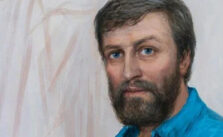Sasha. Artist: Maria Vishnyak Icons should first of all attune you to prayer. If you’re just standing in front of an icon, thinking how well it was painted (or, sadly, how poorly it was painted), that’s wrong. We must stand prayerfully in front of icons and not just stand there; and if you are able to pray, then you can evaluate the artistic skill and reflect on how it was painted. And it is not at all difficult to stand prayerfully in front of many icons created by the hand of Alexander Sokolov.
Anyone who thinks about what modern icons should be like and who studies icon painting should definitely visit the exhibition of Alexander Sokolov’s works, which is being held at the Cathedral of Christ the Savior in Moscow. It is called “Seeing Love” and is dedicated to the memory of the icon-painter: this February marks the tenth anniversary of his death. The exhibition is not a must because you want to paint in this style later or other things. It’s not about that, but about the iconographer’s attitude to what he does: Alexander’s attitude was vivid, real and profound.
The exhibition begins with Alexander Sokolov’s portrait at work, 1988–1989, painted by the artist Maria Vishnyak, the iconographer’s wife. I probably should write, “the iconographer’s widow”, but I can’t; we still see them side by side, together, as two bright inseparable parts of one whole. Maria is a portrait painter, and even in her student days she conveyed the character of an iconographer—contemplative and deep.
 The First Spring. Artist: Maria Vishnyak
The First Spring. Artist: Maria Vishnyak
At the exhibition, works by Maria Vishnyak are side by side with Alexander Sokolov’s, just as they walked side by side, together, through life. This arrangement of the works conveys a true sense of unity, this “togetherness”: Maria’s singing and joyful landscapes and flowers as admiration of this world, and Alexander Sokolov’s icons as the reality of the Heavenly realm.
 The Church of the Protection on the Nerl River. Artist: Maria Vishnyak
The Church of the Protection on the Nerl River. Artist: Maria Vishnyak
Alexander Sokolov was an iconographer who reflects theologically and thinks. It was simply impossible for him to copy one or another image thoughtlessly without comprehending and understanding it in any way.
Alexander perceived icon painting as a path, as an ascetic labor, as work on the improvement of his soul. He walked this path, and eventually painted profound works for the Church and for the faithful…
 The artist Maria Vishnyak by the portrait of her husband Alexander Sokolov
The artist Maria Vishnyak by the portrait of her husband Alexander Sokolov
The exhibition once again reminds us of the great iconographer’s scale. The overall impression is immersion in the artist’s work and awareness that we must all be genuinely devoted to the Church and to creative work as was Sokolov. Even his sketches look like real works of art; in them you can already see how Alexander Sokolov was able to find images, emphasizing the most important things. For example, the icon of the Savior from the waist up (engraving on gesso, 2014), the icon of St. Nicholas the Wonderworker (engraving on gesso, 2014), etc.
There are sketches, icons and icon frames by Alexander, as well as his stone carving experiments at the exhibition. But many of his works are in churches and private collections in Russia and abroad, and so naturally it is impossible to see his monumental projects at the exhibition. But thanks to large-scale photographs of his works, viewers can see Alexander Sokolov’s works quite fully.
For example, while still a young iconographer, Alexander Sokolov painted the Icon of the Mother of God, “The Inexhaustible Cup”, in 1993, now in the Vysotsky Monastery in Serpukhov near Moscow, which became famous for its miracles. Alexander took this fact very sensibly and soberly, without taking credit for it at all:
“For a person who participates in the Church sacraments, miracles are common. After all, we believe in the miracle that bread and wine become the Body and Blood of Christ, we believe that we ourselves partake of Eternal Life through Communion, and this is much more than healing from some physical illness,” the iconographer used to say.
 Icon of the Mother of God, “The Inexhaustible Cup”. Iconographer: Alexander Sokolov
Icon of the Mother of God, “The Inexhaustible Cup”. Iconographer: Alexander Sokolov
What beautiful and spiritual icons of the Most Holy Theotokos he painted! They combine sorrow—for Her Son, for people and for everyone—and love. It is the love that Alexander Sokolov was able to see in his icons. Among the icons of the Mother of God displayed at the exhibition are the Kazan (2014), Lyubyatov (2013), and Vladimir (2013) icons.
 The Lyubyatov Icon of the Mother of God. Iconographer: Alexander Sokolov
The Lyubyatov Icon of the Mother of God. Iconographer: Alexander Sokolov
Of special note is a large printed version of the icon of the holy Royal Martyrs, painted by Alexander Sokolov in 2000, which is kept on Valaam. The iconographer painted their icons more than once, and in this particular version the Tsar and Tsarevich Alexei are depicted in military uniforms. It is considered more correct to depict the Sovereign in ancient Russian royal garments, but in this case the uniform does not look exactly military: it is perceived as an ascetic garment, a symbol of self-denial, the renunciation of his own life. Such an image of St. Nicholas II, as on the icon painted by Alexander Sokolov, is very consistent with the letter in which Princess Olga Nikolaevna cites her father’s words, calling on everybody not to avenge him, but only to pray for all… The ascetic nature of the garments of the Sovereign and the Tsarevich, the robes of the Tsarina and the Grand Duchesses, in which there is red—the color of martyrdom and royalty—all this works to create a deep iconic image.
 The icon of the Royal Martyrs. Iconographer: Alexander Sokolov
The icon of the Royal Martyrs. Iconographer: Alexander Sokolov
As already mentioned, the monumental projects of the iconographer—the frescoes of churches—are displayed as well. For instance, the expressive murals of the Church of the Nativity of Christ in Mytishchi near Moscow.
 Paintings in the apse of the church in Mytishchi. Iconographer: Alexander Sokolov
Paintings in the apse of the church in Mytishchi. Iconographer: Alexander Sokolov
There are also some works that can no longer be seen in their original form—the frescoes at the Church of the Icon of the Mother of God, “The Life-Giving Spring”, in Tsaritsyno in the south of Moscow, which were lost, or simply destroyed (how deplorable it is to write about it). There were some Old Testament scenes that are not so often found in church paintings of modern days, which were theologically interpreted by the iconographer. For example, among the images on the theme of the story of Abel and Cain there is a scene in which Adam and Eve mourn Abel’s death—for the first time in the history of mankind, parents mourn their the death of their child…
 Cain and Abel. From the lost murals of the Church of the Icon of the Mother of God, “The Life-Giving Spring”, in Tsaritsyno
Cain and Abel. From the lost murals of the Church of the Icon of the Mother of God, “The Life-Giving Spring”, in Tsaritsyno
In order to change the effect of sin in the world there will be another Mourning later, when the Mother will press Herself to the image of Her Son. Alexander Sokolov follows an ancient tradition that has existed since the time of early Christian art, when through showing Old Testament events viewers can see events of the New Testament…
Monumental compositions, large icons, small and tiny ones—you want to examine each of them closely, and, regardless of size, each icon is a profound image.
After visiting the exhibition a very calm feeling remains in you, which is the opposite of both indifference and excessive emotion. This is the calm of spiritual tension; because when an iconographer really works, the result is always a “window into the Heavenly realm”, and this can be said about all of Alexander Sokolov’s icons.
The exhibition at the Cathedral of Christ the Savior will last until February 26, 2025.

